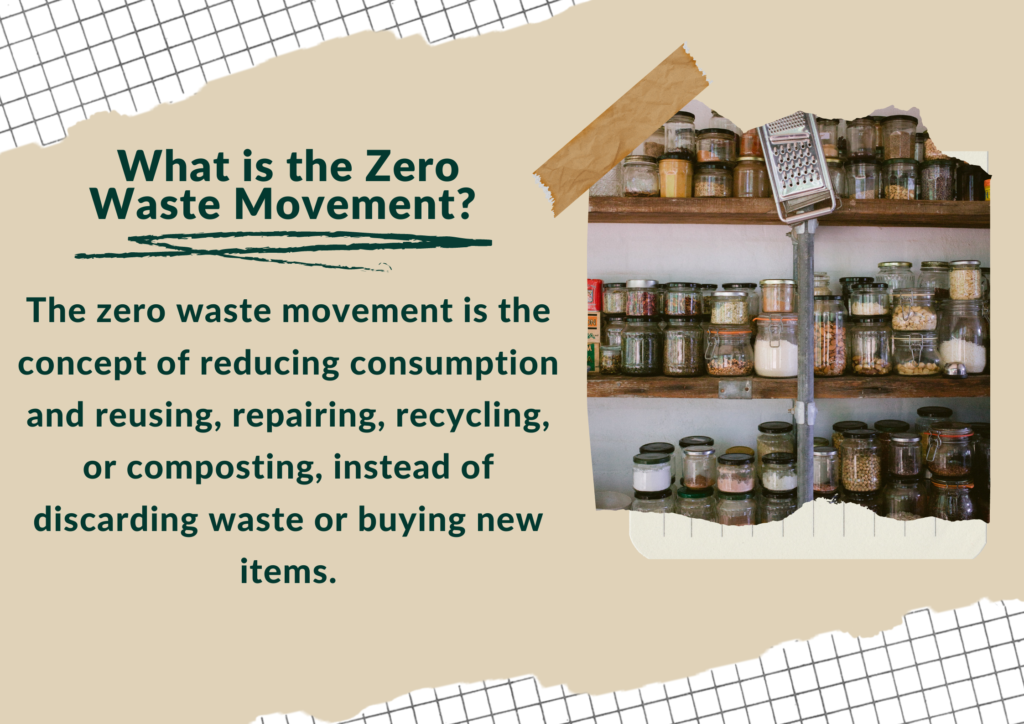While the average person may not realise it, as a society we generate a ton of waste every day. It can be hidden in residential households, small businesses, and large corporations. The zero waste movement aims to change that by encouraging a change of habits and lifestyle.
Being zero waste is a growing lifestyle trend that’s challenging the status quo on how we make our purchases, our everyday lifestyle, and our outlook on what constitutes as waste.
The zero waste movement is a social movement that’s based on the concept of reducing consumption and reusing, repairing and recycling instead of discarding waste or producing new materials.
What Does Zero Waste Mean?
Being zero waste means reducing the amount of rubbish generated in your home and making sure any waste generated is either reused, recycled or composted.

What is the goal of the Zero Waste movement?
The aim of the Zero Waste movement is to reduce and ultimately eliminate waste. People who live a zero waste lifestyle are aiming to establish a society where virgin resources are used sparingly, and the lifespan of existing products is extended as much as possible.
It’s a way of life that encourages individuals, businesses, and governments to reduce, reuse, repair and recycle. It follows the principles of creating “least waste” – which means doing everything in your power to minimise the amount of materials sent to a landfill, or an other disposal site.
The History of the Zero Waste Movement
The zero waste movement first gained publicity in the early 2000’s and has since moved from a concept into an actual actionable lifestyle. The first zero waste initiatives were actually set up by organisations to to achieve more environmentally friendly waste management targets.
In 2001, the California Integrated Waste Management Board set a plan to create a “zero-waste California” by reducing, reusing or recycling all municipal solid waste materials. By 2012 this initiative encouraged San Francisco to divert 80% of its waste from landfill, and help it become the greenest city in North America.
Being zero waste wasn’t a consumer lifestyle choice until the phrase was popularised by Bea Johnson, a French American writer. In 2009 she began to write a blog about her family’s minimalist habits, which lead her to author her bestselling book: Zero Waste Home: The Ultimate Guide to Simplifying Your Life by Reducing Your Waste.
Johnson’s book and subsequent activism brought the ideals of a waste free lifestyle to the mainstream audience, and inspired many people reduce their consumption to benefit the environment. Many successful bloggers have also built large followings around their zero waste habits.
What does the Zero Waste movement look like?
The Zero Waste movement takes many different forms, depending on where you look.
Zero Waste organisations such as Zero Waste Scotland aim to educate individuals and businesses on the benefits of a circular economy, and offer free sustainability advice and support for my Scottish companies.
This modern embodiment of the zero waste philosophy is also embodied through various individuals and bloggers who have shared their zero waste lifestyles through tutorials and articles.
Why Live a zero waste lifestyle?
People who live a zero waste lifestyle are doing so for a variety of reasons and motivations, but the main one is environmental. Reducing waste and reusing what you already own will reduce the amount of material that is sent to landfill.
Consumers are often unfairly burdened with the control over how we live a more sustainable lifestyle, and many valid arguments have been made to show that being completely zero waste is impossible, and that “zero” means “almost zero”.
But the prevailing ideal of a circular economy is the same: that by keeping waste out of landfills, we can reduce the environmental impact of waste by encouraging the reuse of materials, recycling, and reduction of single-use items.
Benefits of being Zero Waste
There are numerous environmental, economic and cultural benefits of being zero waste including:
- Reduces our impact on the environment
- Minimises pollution
- Conserves natural resources
- Can create jobs in waste management
- Helps to build communities
How to Become Zero Waste
Becoming zero waste is a process. It’s a journey that requires change and commitment. But the good news is that it’s also a journey that can be fun and rewarding. There are many ways to lead a more sustainable and less wasteful lifestyle. The key is to find what works best for you.
There’s a lot to it and not everyone has the dedication or motivation to stick with it. But, if you’re seeking to reduce waste and live sustainably, becoming a zero waste household could be the next step for you.
Start small: try to reduce one thing at a time. This could be the amount of food you bring into the house, the number of items you buy with plastic wrapping in your food shop, or switching to a reusable water bottle. You could try swapping to zero waste products slowly as you use up your existing items.
One simple change to start with could be tea bags, we’ve done the research to find out which are the most sustainable and plastic-free tea brands to help you!
Be mindful: be mindful of how you spend your money and what you purchase. This will enable you to identify items that you don’t need and make better choices as to what you do need.
Work toward your long-term goal: the best way to become zero waste is to set small goals and achieve them one at a time.
If you’re worried about it costing an arm and a leg to shop for plastic-free items, we’ve created a handful of tips to help you start being zero waste without spending more money. Many of the included tips won’t cost you anything!
The 5 R’s
To help make the switch to a zero waste lifestyle, Bea Johnson, author of Zero Waste Home, outlined five simple principles to help reduce the amount of waste you produce. These principles are known as the 5 Rs of zero waste and are designed to help minimise your consumption.
The 5 Rs of zero waste are Refuse, Reduce, Reuse, Recycle, and Rot. The R’s are in order of importance, so refusing plastic should always be the first and foremost and putting items in the recycle bin should always be one of your last resorts.
How to help your community become zero waste
Every community has its own unique challenges when it comes to reducing waste. In many countries around the world, waste management is a problem. You can start small by volunteering for an environmental organisation, joining a community garden, or donating used items to charity.
But don’t stop there.
You can also take matters into your own hands. This might look different for everyone depending on where you live, but here are some ideas:
- Donate unused items to a local charity or shelter.
- Put up signs in your community asking people to reduce waste.
- Host a community composting or recycling event.
- Take on a leadership role with your school or community organisation to promote better waste management practices.
Conclusion
Living a zero waste lifestyle isn’t easy, it requires a significant commitment and change in lifestyle. But, with the right motivation and preparation, you can make the shift to a more sustainable lifestyle with less waste, or even little to none, if you’re dedicated.
Now that you understand what the zero waste movement is and why it’s important, it’s time to get started. You’ve got this.





